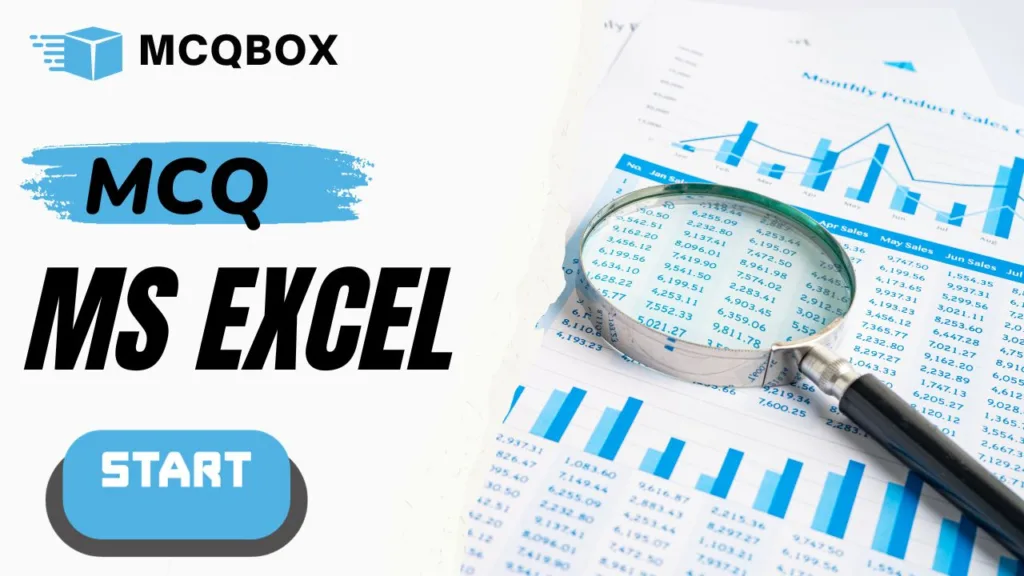MCQ on MS EXCEL for all Competitive exams
“Test your proficiency in MS Excel with this set of multiple-choice questions. From basic functions to advanced formulas, this excel MCQ questions covers various aspects of spreadsheet management. Challenge yourself with questions on formatting, data analysis, and functions to gauge your Excel knowledge.”

Online Excel Assessment Test
Table of Contents
Microsoft Excel, a universal software in offices, classrooms, and homes, stands as a versatile tool for data management, analysis, and visualization. As we explore into the workings of Excel, let’s uncover its origins and evolution, explore its features, understand its role in various fields, and discover tips and tricks to master this powerful spreadsheet software.
History of Microsoft Excel
Microsoft Excel was first introduced in 1985 for the Apple Macintosh. Developed by Microsoft, it quickly gained popularity for its user-friendly interface and spreadsheet capabilities. Over the years, it became an integral part of the Microsoft Office suite.
Evolution and Major Updates
With each version, Microsoft Excel evolved, incorporating new features and improving functionality. Major updates, such as the introduction of the ribbon interface and integration with cloud services, have kept Excel at the forefront of spreadsheet software.
Key Features of Microsoft Excel
Spreadsheet Functionality
At its core, Excel serves as a powerful spreadsheet application, allowing users to organize data in cells, rows, and columns. The grid-like structure simplifies data entry, making it an essential tool for businesses, educators, and individuals.
Formulas and Functions
One of Excel’s strengths lies in its ability to perform complex calculations using formulas and functions. From basic arithmetic to advanced statistical analysis, Excel caters to a wide range of mathematical tasks.
Data Visualization Tools
Excel goes beyond mere number crunching with robust data visualization tools. Users can create compelling charts, graphs, and pivot tables, providing a visual representation of data trends and patterns.
Excel Interface and Navigation
Ribbon and Tabs
The ribbon interface, introduced in Excel 2007, revolutionized navigation. It organizes commands into tabs and groups, streamlining access to various features. This intuitive design has contributed to Excel’s accessibility for users of all skill levels.
Cells, Rows, and Columns
Understanding the fundamentals of cells, rows, and columns is crucial for efficient data management. Excel allows customization of these elements, providing flexibility in organizing and presenting information.
Customization Options
Personalizing the Excel experience is key to efficiency. Users can customize the ribbon, create templates, and use themes to tailor Excel to their specific needs and preferences.
Common Excel Tasks
Data Entry and Formatting
Excel simplifies data entry through its user-friendly interface. Additionally, formatting options allow users to present data professionally, enhancing readability and overall visual appeal.
Sorting and Filtering
Effortlessly sort and filter large datasets with Excel’s sorting and filtering functions. Whether organizing alphabetical lists or analyzing numerical data, these features streamline the process.
Creating Charts and Graphs
Transforming data into visual representations is made easy with Excel’s chart and graph creation tools. Choose from various chart types to effectively communicate trends and insights.
Advanced Excel Functions
PivotTables and Pivot Charts
PivotTables enable dynamic data analysis, allowing users to summarize and analyze large datasets. PivotCharts complement this functionality, providing visual representations of complex data relationships.
Macros and Automation
Excel’s automation capabilities shine through the use of macros. Users can record repetitive tasks and create automated processes, significantly boosting productivity.
Collaboration Features
Collaboration is seamless with Excel’s shared workbooks and real-time co-authoring. Multiple users can edit a spreadsheet simultaneously, fostering teamwork and efficiency.
Excel in Business and Finance
Financial Modeling
Excel is the go-to tool for financial modeling. Businesses utilize its advanced functions to create intricate financial models, aiding in decision-making processes and strategic planning.
Budgeting and Forecasting
From small businesses to multinational corporations, Excel is instrumental in budgeting and forecasting. Its flexibility allows for dynamic adjustments based on changing variables.
Data Analysis for Decision Making
In business, informed decisions rely on accurate data analysis. Excel’s data analysis tools empower organizations to derive actionable insights from complex datasets.
